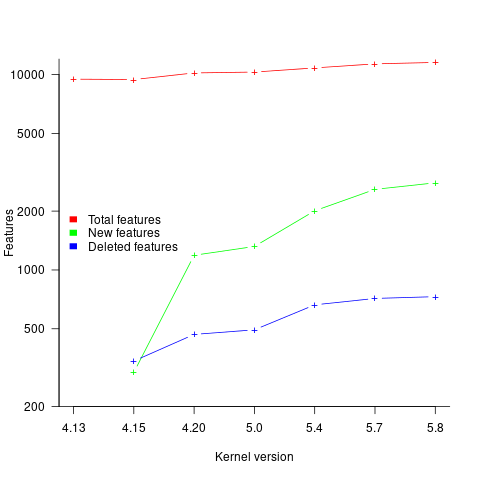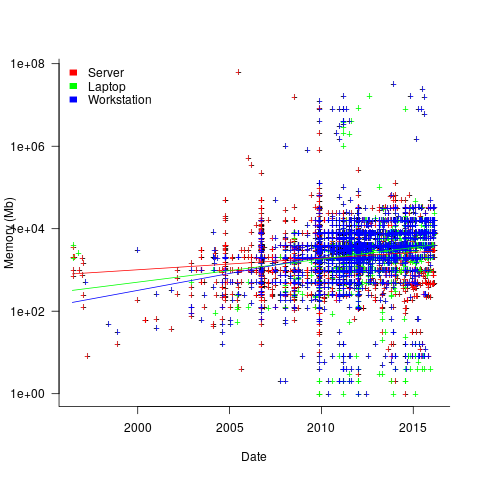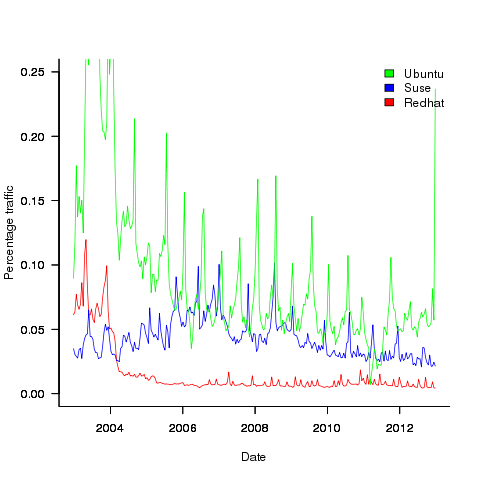Archive
Predicting the size of the Linux kernel binary
How big is the binary for the Linux kernel? Depending on the value of around 15,000 configuration options, the size of the version 5.8 binary could be anywhere between 7.3Mb and 2,134 Mb.
Who is interested in the size of the Linux kernel binary?
We are not in the early 1980s, when memory for a desktop microcomputer often topped out at 64K, and software was distributed on 360K floppies (720K when double density arrived; my companies first product was a code optimizer which reduced program size by around 10%).
While desktop systems usually have oodles of memory (disk and RAM), developers targeting embedded systems seek to reduce costs by minimizing storage requirements, security conscious organizations want to minimise the attack surface of the programs they run, and performance critical systems might want a kernel that fits within a processors’ L2/L3 cache.
When management want to maximise the functionality supported by a kernel within given hardware resource constraints, somebody gets the job of building kernels supporting various functionality to find out the size of the binaries.
At around 4+ minutes per kernel build, it’s going to take a lot of time (or cloud costs) to compare lots of options.
The paper Transfer Learning Across Variants and Versions: The Case of Linux Kernel Size by Martin, Acher, Pereira, Lesoil, Jézéquel, and Khelladi describes an attempt to build a predictive model for the size of the kernel binary. This paper includes an extensive list of references.
The author’s approach was to first obtain lots of kernel binary sizes by building lots of kernels using random permutations of on/off options (only on/off options were changed). Seven kernel versions between 4.13 and 5.8 were used, producing 243,323 size/option setting combinations (complete dataset). This data was used to train a machine learning model.
The accuracy of the predictions made by models trained on a single kernel version were accurate within that kernel version, but the accuracy of single version trained models dropped dramatically when used to predict the binary size of later kernel versions, e.g., a model trained on 4.13 had an accuracy of 5% MAPE predicting 4.13, when predicting 4.15 the accuracy is 20%, and 32% accurate predicting 5.7.
I think that the authors’ attempt to use this data to build a model that is accurate across versions is doomed to failure. The rate of change of kernel features (whose conditional compilation is supported by one or more build options) supported by Linux is too high to be accurately modelled based purely on information of past binary sizes/options. The plot below shows the total number of features, newly added, and deleted features in the modelled version of the kernel (code+data):

What is the range of impacts of each build option, on binary size?
If each build option is independent of the others (around 44% of conditional compilation directives in the kernel source contain one option), then the fitted coefficients of a simple regression model gives the build size increment when the corresponding option is enabled. After several cpu hours, the 92,562 builds involving 9,469 options in the version 4.13 build data were fitted. The plot below shows a sorted list of the size contribution of each option; the model  is 0.72, i.e., quite a good fit (code+data):
is 0.72, i.e., quite a good fit (code+data):

While the mean size increment for an enabled option is 75K, around 40% of enabled options decreases the size of the kernel binary. Modelling pairs of options (around 38% of conditional compilation directives in the kernel source contain two options) will have some impact on the pattern of behavior seen in the plot, but given the quality of the current model ( is 0.72) the change is unlikely to be dramatic. However, the simplistic approach of regression fitting the 90 million pairs of option interactions is not practical.
is 0.72) the change is unlikely to be dramatic. However, the simplistic approach of regression fitting the 90 million pairs of option interactions is not practical.
What might be a practical way of estimating binary size for any kernel version?
The size of a binary is essentially the quantity of code+static data it contains.
An estimate of the quantity of conditionally compiled source code dependent on a given option is likely to be a good proxy for that option’s incremental impact on binary size.
It’s trivial to scan source code for occurrences of options in conditional compilation directives, and with a bit more work, the number of lines controlled by the directive can be counted.
There has been a lot of evidence-based research on software product lines, and feature macros in particular. I was expecting to find a dataset listing the amount of code controlled by build options in Linux, but the data I can find does not measure Linux.
The Martin et al. build data is perfectfor creating a model linking quantity of conditionally compiled source code to change of binary size.
Analysis of a subset of the Linux Counter data
The Linux Counter project was started in 1993, with the aim of tracking the growth of Linux users (the kernel was first released two years earlier). Anybody could register any of their machines running Linux; a user ran a script that gathered basic information about a machine, and the output was emailed to the project. Once registered, users received an annual reminder to update information in their entry (despite using Linux since before the 1.0 release, user #46406 didn’t register until 2001).
When it closed (reopened/closed/coming back) it had 120K+ registered users. That’s a lot of information about computers, which unfortunately is not publicly available. I have not had any replies to my emails to those involved, asking for a copy that could be released in anonymized form.
This week I found 15,906 rows of what looks like a subset of the Linux counter data, most entries are post-2005. What did I learn from this data?
An obvious use is the pattern to check is changes over time. While the data does not include any explicit date, it does include the Kernel version, from which the earliest date can be inferred.
An earlier post used SPEC data to estimate the growth in installed memory over time; it has been doubling every 840 days, give or take. That data contains one data point per distinct vendor computer; the Linux counter data contains one entry per computer in use. There is around thirty pairs of entries for updated systems, i.e., a user updated the entry for an existing system.
The plot below shows memory installed in each registered computer, over time, for servers, laptops and workstations, with fitted regression lines. The memory size doubling times are: servers 4,000 days, laptops 2,000 days, and workstations 1,300 days (code+data):

A regression model using dates is a good fit in the statistical sense, but explain very little of the variance in the data. The actual date on which the memory size was selected may have been earlier (because the kernel has been updated to a later release), or later (because memory was added, but the kernel was not updated).
Why is the memory doubling time so long?
Has memory size now reached the big-enough boundary, do Linux counter users keep the same system for many years without upgrading, are Linux counter systems retired Windows boxes that have been repurposed (data on installed memory Windows boxes would answer this point)?
Suggestions welcome.
When memory capacity is limited, it may be useful to swap least recently used memory contents to disc; Linux setup includes the specification of a swap partition. What is the optimal size of the size partition? A common recommendation is: if memory is less than 2G swap size is twice memory; if between 2-8G swap size is the same as memory, and for greater than 8G, half of memory size. The table below shows the percentage of particular system classes having a given swap/memory ratio (rounding the list of ratios to contain one decimal digit produces a list of over 100 ratio values).
swap/memory Server Workstation Laptop 1.0 15.2 19.9 25.9 2.0 10.3 9.6 8.6 0.5 9.5 7.7 8.4 |
The plot below shows memory against swap partition size, for the system classes laptop, server and workstation, with fitted regression line (code+data):

The available disk space also has a (small) impact on swap partition size; the following model explains 46% of the variance in the data:  .
.
I was hoping to confirm the rate of installed memory growth suggested by the SPEC data, with installed systems lagging a few years behind the latest releases. This Linux counter data tells a very different growth story. Perhaps pre-2005 data will tell another story (I just need to find it).
I’m not sure if the swap/memory ratio analysis is of any use to systems people. It was something of a fishing expedition on my part.
Other counting projects have included the Ubuntu counter project, and Hardware for Linux which is still active and goes back to August 2014.
I’m interested in hearing about the availability of any other Linux counter data, or data from other computer counting projects.
Linux has a sleeper agent working as a core developer
The latest news from Wikileaks, that GCHQ, the UK’s signal intelligence agency, has a sleeper agent working as a trusted member on the Linux kernel core development team should not come as a surprise to anybody.
The Linux kernel is embedded as a core component inside many critical systems; the kind of systems that intelligence agencies and other organizations would like full access.
The open nature of Linux kernel development makes it very difficult to surreptitiously introduce a hidden vulnerability. A friendly gatekeeper on the core developer team is needed.
In the Open source world, trust is built up through years of dedicated work. Funding the right developer to spend many years doing solid work on the Linux kernel is a worthwhile investment. Such a person eventually reaches a position where the updates they claim to have scrutinized are accepted into the codebase without a second look.
The need for the agent to maintain plausible deniability requires an arm’s length approach, and the GCHQ team made a wise choice in targeting device drivers as cost-effective propagators of hidden weaknesses.
Writing a device driver requires the kinds of specific know-how that is not widely available. A device driver written by somebody new to the kernel world is not suspicious. The sleeper agent has deniability in that they did not write the code, they simply ‘failed’ to spot a well hidden vulnerability.
Lack of know-how means that the software for a new device is often created by cutting-and-pasting code from an existing driver for a similar chip set, i.e., once a vulnerability has been inserted it is likely to propagate.
Perhaps it’s my lack of knowledge of clandestine control of third-party computers, but the leak reveals the GCHQ team having an obsession with state machines controlled by pseudo random inputs.
With their background in code breaking I appreciate that GCHQ have lots of expertise to throw at doing clever things with pseudo random numbers (other than introducing subtle flaws in public key encryption).
What about the possibility of introducing non-random patterns in randomised storage layout algorithms (he says waving his clueless arms around)?
Which of the core developers is most likely to be the sleeper agent? His codename, Basil Brush, suggests somebody from the boomer generation, or perhaps reflects some personal characteristic; it might also be intended to distract.
What steps need to be taken to prevent more sleeper agents joining the Linux kernel development team?
Requiring developers to provide a record of their financial history (say, 10-years worth), before being accepted as a core developer, will rule out many capable people. Also, this approach does not filter out ideologically motivated developers.
The world may have to accept that intelligence agencies are the future of major funding for widely used Open source projects.
Update
Turns out the sleeper agent was working on xz.
Predicting the future with data+logistic regression
Predicting the peak of data fitted by a logistic equation is attracting a lot of attention at the moment. Let’s see how well we can predict the final size of a software system, in lines of code, using logistic regression (code+data).
First up is the size of the GNU C library. This is not really a good test, since the peak (or rather a peak) has been reached.

We need a system that has not yet reached an easily recognizable peak. The Linux kernel has been under development for many years, and lots of LOC counts are available. The plot below shows a logistic equation fitted to the kernel data, assuming that the only available data was up to day: 2,900, 3,650, 4,200, and 5,000+. Can you tell which fitted line corresponds to which number of days?

The underlying ‘problem’ is that we are telling the fitting software to fit a particular equation; the software does what it has been told to do, and fits a logistic equation (in this case).
A cubic polynomial is also a great fit to the existing kernel data (red line to the left of the blue line), and this fitted equation can be extended into future (to the right of the blue line); dotted lines are 95% confidence bounds. Do any readers believe the future size of the Linux kernel predicted by this cubic model?

Predicting the future requires lots of data on the underlying processes that drive events. Modeling events is an iterative process. Build a model, check against reality, adjust model, rinse and repeat.
If the COVID-19 experience trains people to be suspicious of future predictions made by models, it will have done something positive.
2019 in the programming language standards’ world
Last Tuesday I was at the British Standards Institute for a meeting of IST/5, the committee responsible for programming language standards in the UK.
There has been progress on a few issues discussed last year, and one interesting point came up.
It is starting to look as if there might be another iteration of the Cobol Standard. A handful of people, in various countries, have started to nibble around the edges of various new (in the Cobol sense) features. No, the INCITS Cobol committee (the people who used to do all the heavy lifting) has not been reformed; the work now appears to be driven by people who cannot let go of their involvement in Cobol standards.
ISO/IEC 23360-1:2006, the ISO version of the Linux Base Standard, has been updated and we were asked for a UK position on the document being published. Abstain seemed to be the only sensible option.
Our WG20 representative reported that the ongoing debate over pile of poo emoji has crossed the chasm (he did not exactly phrase it like that). Vendors want to have the freedom to specify code-points for use with their own emoji, e.g., pineapple emoji. The heady days, of a few short years ago, when an encoding for all the world’s character symbols seemed possible, have become a distant memory (the number of unhandled logographs on ancient pots and clay tablets was declining rapidly). Who could have predicted that the dream of a complete encoding of the symbols used by all the world’s languages would be dashed by pile of poo emoji?
The interesting news is from WG9. The document intended to become the Ada20 standard was due to enter the voting process in June, i.e., the committee considered it done. At the end of April the main Ada compiler vendor asked for the schedule to be slipped by a year or two, to enable them to get some implementation experience with the new features; oops. I have been predicting that in the future language ‘standards’ will be decided by the main compiler vendors, and the future is finally starting to arrive. What is the incentive for the GNAT compiler people to pay any attention to proposals written by a bunch of non-customers (ok, some of them might work for customers)? One answer is that Ada users tend to be large bureaucratic organizations (e.g., the DOD), who like to follow standards, and might fund GNAT to implement the new document (perhaps this delay by GNAT is all about funding, or lack thereof).
Right on cue, C++ users have started to notice that C++20’s added support for a system header with the name version, which conflicts with much existing practice of using a file called version to contain versioning information; a problem if the header search path used the compiler includes a project’s top-level directory (which is where the versioning file version often sits). So the WG21 committee decides on what it thinks is a good idea, implementors implement it, and users complain; implementors now have a good reason to not follow a requirement in the standard, to keep users happy. Will WG21 be apologetic, or get all high and mighty; we will have to wait and see.
My no loops in R hair shirt
Being professional involved with analyzing source code I get to work with a much larger number of programming languages than most people. There is a huge difference between knowing the intricate details of the semantics of a language and being able to fluently program in a language like a native developer. There are languages whose semantics I probably know better than nearly all its users and yet can only code in like a novice, and there are languages whose reference manual I might have read once and yet can write fluently.
I try not to learn new languages in which to write programs, they just clutter my brain. It can be very embarrassing having somebody sitting next to me while I write an example and not be able to remember whether the language I am using requires a then in its if-statement or getting the details of a print statement wrong; I am supposed to be a computer language expert.
Having decided to migrate from being a casual R user to being a native user (my current status is somebody who owns more than 10 books that make extensive use of R) I resolved to invest the extra time needed to learn how to write code the ‘R-way’ (eighteen months later I’m not sure that there is an ‘R way’ in the sense that could be said to exist in other languages, or if there is it is rather diffuse). One of my self-appointed R-way rules is that any operation involving every element of a vector should be performed using whole vector operations (i.e., no looping constructs).
Today I was analyzing the release history of the Linux kernel and wanted to get the list of release dates for the current version of the major branch; I had a list of dates for every release. The problem is that when a major release branch is started previous branches, now in support only mode, may continue to be maintained for some time, for instance after the version 2.3 branch was created the version 2.2 branch continued to have releases made for it for another five years.
The obvious solution to removing non-applicable versions from the release list is to sort on release date and then loop through the elements removing those whose version number was less than the version appearing before them in the list. In the following excerpt the release of 2.3.0 causes the following 2.2.9 release to be removed from the list, also versions 2.0.37 and 2.2.10 should be removed.
Version Release_date 2.2.8 1999-05-11 2.3.0 1999-05-11 2.2.9 1999-05-13 2.3.1 1999-05-14 2.3.2 1999-05-15 2.3.3 1999-05-17 2.3.4 1999-06-01 2.3.5 1999-06-02 2.3.6 1999-06-10 2.0.37 1999-06-14 2.2.10 1999-06-14 2.3.7 1999-06-21 2.3.8 1999-06-22 |
While this is an easy problem to solve using a loop, what is the R-way of solving it (use the xyz package would be the answer half said in jest)? My R-way rule did not allow loops, so a-head scratching I did go. On the assumption that the current branch version dates would be intermingled with releases of previous branches I decided to use simple pair-wise comparison (which could be coded up as a whole vector operation); if an element contained a version number that was less than the element before it, then it was removed.
Here is the code (treat step parameter was introduced later as part of the second phase tidy up; data here):
ld=read.csv("/usr1/rbook/examples/regression/Linux-days.csv") ld$Release_date=as.POSIXct(ld$Release_date, format="%d-%b-%Y") ld.ordered=ld[order(ld$Release_date), ] strip.support.v=function(version.date, step) { # Strip off the least significant value of the Version id v = substr(version.date$Version, 1, 3) # Build a vector of TRUE/FALSE indicating ordering of element pairs q = c(rep(TRUE, step), v[1:(length(v)-step)] <= v[(1+step):length(v)]) # Only return TRUE entries return (version.date[q, ]) } h1=strip.support.v(ld.ordered, 1) |
This pair-wise approach only partially handles the following sequence (2.2.10 is greater than 2.0.37 and so would not be removed).
2.3.6 1999-06-10 2.0.37 1999-06-14 2.2.10 1999-06-14 2.3.7 1999-06-21 |
The no loops rule prevented me iterating over calls to strip.support.v until there were no more changes.
Would a native R speaker assume there would not be many extraneous Version/Release_date pairs and be willing to regard their presence as a minor data pollution problem? If so I have some way to go before I might be able to behave as a native.
My next line of reasoning was that any contiguous sequence of non-applicable version numbers would probably be a remote island in a sea of applicable values. Instead of comparing an element against its immediate predecessor it should be compared against an element step back (I chose a value of 5).
h2=strip.support.v(h1, 5) |
The original vector contained 832 rows, which was reduced to 745 and then down to 734 on the second step.
Are there any non-loop solutions that are capable of handling a higher density of non-applicable values? Do tell if you can think of one.
Update (a couple of days later)
Thanks to Charles Lowe, Wojtek and kaz_yos for their solutions using cummax, a function that I was previously unaware of. This was a useful reminder that what other languages do in the syntax/semantics R surprisingly often does via a function call (I’m still getting my head around the fact that a switch-statement is implemented via a function in R); as a wannabe native R speaker I need to remove my overly blinked language approach to problems and learn a lot more about the functions that come as part of the base system
 %, would not have passed).
%, would not have passed).
Recent Comments